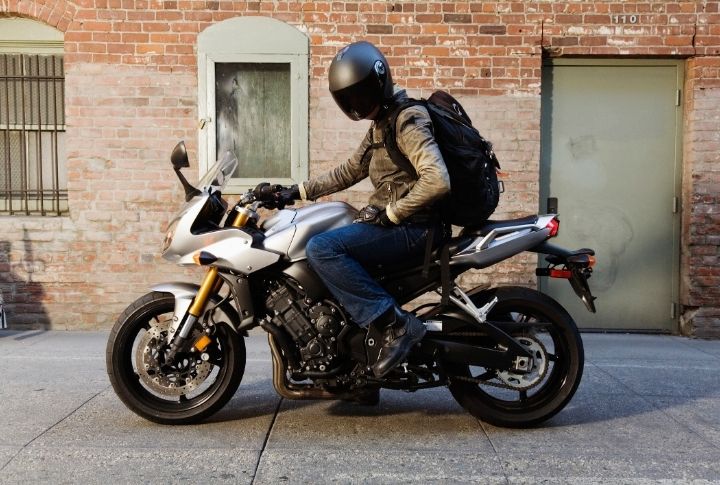
15 Tips For a Fun and Safe Solo Motorcycle Ride

Why did the motorcycle go on a solo trip? Because it was “two-tired” of the same old routine! But seriously, solo motorcycle rides offer a unique thrill and sense of freedom. In case you want to be the next Ted Simon or Ewan McGregor, here are 15 tips to ensure you have a safe and wonderful ride.
Choose the Right Motorcycle

Your motorcycle should be reliable, comfortable for the duration of your ride, and suited to the terrain you’ll be tackling. Consider factors like seat height, fuel capacity, and ground clearance to ensure your bike is a good match for your solo adventure. Ensure you’re familiar with your motorcycle’s maintenance needs and repair history to minimize the risk of breakdowns on the road.
Get Thorough Maintenance

Before you set off, have your motorcycle serviced by a qualified mechanic to ensure everything is in top condition. This should include checks on tire pressure, oil levels, brake pads, and suspension, as well as any other critical systems.
Plan Your Route

Don’t just wing it. Carefully plan your route, considering distance, rest stops, fuel availability, and road conditions. Use mapping tools or GPS devices to get an accurate estimate of your journey and identify potential hazards or challenges along the way.
Pack Light

The more you carry, the heavier your motorcycle will be, affecting its handling and performance. Pack smart by bringing only the essentials. Select layers that you can easily put on or take off as the weather changes.
Let Someone Know Your Plans

Tell a friend or family member about your route and estimated timeframe. This way, someone will know where you’re headed and can raise an alarm if something goes wrong. Also, share your itinerary with a roadside assistance service or a motorcycle club and provide them with your emergency contact details.
Dress for the Ride

Wear protective gear, including a jacket, helmet, pants, gloves, and boots. Choose gear that is durable, comfortable, and suitable for the weather. Don’t forget to add reflective strips or bright colors to increase your visibility on the road, and consider wearing a back protector for extra support.
Be Weather Aware

Check the forecast before you leave, and be prepared for changing weather patterns. Carry a small portable weather radio to stay informed on the go. Ensure you know how to read signs of changing weather, such as darkening skies or dropping temperatures, and be prepared to adjust your route or take shelter if needed.
Ride Within Your Limits

Don’t push yourself or your motorcycle beyond your capabilities. Be honest about your skill level and experience, and avoid routes or maneuvers that make you feel uncomfortable or unsure. Take frequent breaks to rest and reassess your fatigue level, and don’t hesitate to turn back or seek guidance if you’re feeling overwhelmed.
Schedule Regular Breaks

Use your scheduled breaks to refuel, rehydrate, and rest your eyes, and take a short walk or do some light stretching to keep your blood flowing. Breaks are a great opportunity to inspect your motorcycle and make any necessary adjustments, as well as to take in the scenery and enjoy the journey.
Be Visible

In addition to the bright clothing and reflective gear, add reflective strips or decals to your motorcycle, and use headlights and taillights to increase your visibility even in daylight. By being more visible, you’ll reduce your risk of being involved in an accident, and you’ll be able to ride with greater confidence and peace of mind.
Respect the Road

Adhere to traffic laws and be considerate of other drivers. Use your turn signals, check your mirrors regularly, and anticipate the actions of other road users to maintain a safe and smooth ride. Being a responsible and considerate rider will also help to promote a positive image of motorcyclists and promote better understanding and tolerance on the road.
Phone on Silent

Keep your eyes on the road and your hands on the handlebars, and avoid engaging in conversations, texting, or browsing while in motion. Many states have laws prohibiting handheld phone use while riding, so keeping your phone silent and out of reach can also help you avoid costly fines.
Use The Safety Features

Many modern motorcycles come equipped with advanced safety features like Anti-lock Braking Systems (ABS) and Traction Control. ABS helps avoid wheel lockup during hard braking, while Traction Control reduces power to the wheels to prevent slipping. These features can significantly reduce your risk of accidents, so make sure to understand how to use them and always enable them when riding.
Bring a Tool Kit

Pack a basic tool kit to address minor roadside repairs. Include essentials like a screwdriver, pliers, wrench, tire pressure gauge, plug kit, and a small air compressor for added convenience. With a tool kit, you can make adjustments and conduct maintenance checks regularly to ensure your motorcycle runs smoothly.
Be Prepared for Emergencies

Carry a first-aid kit and emergency contact information. Relax, take in the scenery, and savor the experience of a solo motorcycle adventure. In case of an accident or medical emergency, having a first-aid kit and contact information readily available can help ensure you receive prompt and appropriate care.


